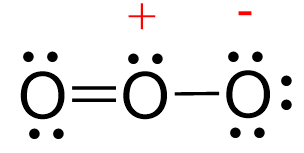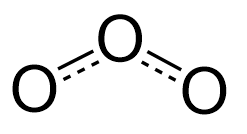In this post, we will be drawing the Lewis structure of ozone, O3.
The first thing we need to do when drawing a Lewis structure is determine the total number of valence electrons in the molecule. Remember, valence electrons are those in the outermost principal energy level. For example: Na – 1s22s22p63s1, Cl – 1s22s22p63s23p5
The number of valence electrons, for main group elements, corresponds to their group number in the periodic table:

For d block elements, the outermost d electrons are also counted as valence electrons (ns + (n-1)d). For example, iron has eight valence electrons: Fe – 1s22s22p63s23p64s23d6.
So, oxygen is in group 6A, and therefore, it has 6 valence electrons, thus O3 has 3 x 6 = 18 valence electrons.
Next, we need to connect the atoms in the correct order and add the electrons as bonds and lone pairs.
In short, these are the steps you need to follow for drawing a Lewis structure:
1. Write the correct skeletal structure for the molecule.
* Hydrogen atoms are always terminal (only one bond)
* Put more electronegative elements in terminal positions
2. Sum the valence electrons from all the atoms.
3. Use a pair of electrons to form a bond between each pair of bound atoms.
4. Add the remaining electrons to satisfy the octet for a more electronegative atom first.
5. If any atoms lack an octet, make a double or triple bond to give them an octet.
Out of the 18 electrons, four are going to make two bonds between the three atoms:

Notice that the bonds can be shown as a line and in fact, this is the most common way of showing structures once we learn the principles of Lewis structures.
We now have 14 valence electrons left, and since the middle oxygen has two bonds while the terminal oxygens have one, we add them to terminal oxygens as two pairs:

Next, check if the atoms have octet. The middle oxygen is surrounded by six electrons, and we move one of the lone pairs to make a double bond:

And now all three oxygens have complete octet:

Next, we check for formal charges. Remember, less charges is better and if there is a way to neutralize the charges by making more bonds, we do it unless it violates the octet for the second-row elements.
We can use this formula for calculating formal charges:
FC= V – (N + B)
Where:
V – number of valence electrons
N – number of nonbonding electrons
B – number of bonds
So, the formal charge of the left oxygen will be:
FC (N) = 6 – (4 + 2) = 0
Middle oxygen: FC (O) = 6 – (2 + 3) = +1
Right oxygen: FC (O) = 6 – (6 + 1) = -1

So this is a correct Lewis structure of ozone and, overall, the molecule is neutral because the formal charges cancel out.
The negative charge is spread between the two terminal oxygens via resonance structures which are separated by double-headed arrows:

The green arrows demonstrating the movement of electrons are called cured arrows and these are more common in organic chemistry.
Keep in mind that the actual structure of the molecule is intermediate between the two (or more) resonance structures and is called a resonance hybrid.

Notice also that the molecular geometry of ozone is bent because the central atom is connected to two atoms and has one lone pair.
Check this 90-question, Multiple-Choice Quiz on Chemical Bonding:
Check Also
- Lewis Dot Symbols
- The Ionic Bond
- The Covalent Bond
- Sigma and Pi Bonds
- Electronegativity and Bond Polarity
- The Octet Rule
- Formal Charges
- Lewis Structures and the Octet Rule
- Lewis Structures Practice Problems
- Resonance Structures

